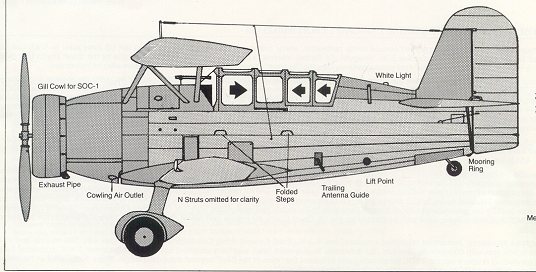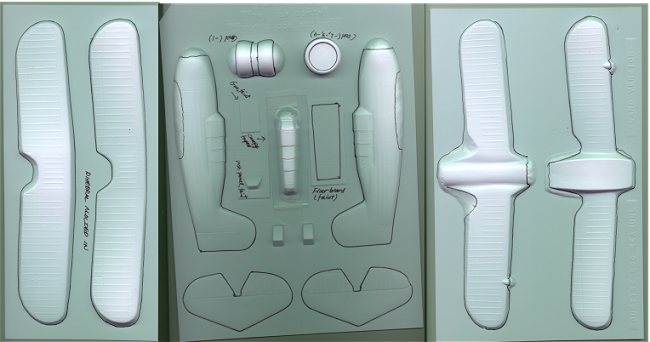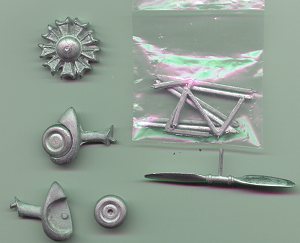
|
KIT: |
Wings 48 1/48 SOC 'Seagull' |
|
KIT # |
4813 |
|
PRICE: |
$19.95 |
|
DECALS: |
none |
|
REVIEW & |
|
|
NOTES: |
Vacuform with white metal` |

|
HISTORY |
The Curtiss SOC "Seagull" was the only aircraft to serve aboard every carrier, every battleship and every cruiser prior to WWII. Though antiquated when it entered service, it outlived its successor (the ill-fated SO3C-1), serving throughout the war, and seeing combat in every theater in which the US Navy was involved.
Designed to replace the aging Vought "Corsair" series, the prototype XO3C-1 first flew in 1934, beating out Vought’s XO5U-1 and Douglas’ XO2D-1 entries in competitive trials. The first of 135 production machines was delivered to the cruiser USS <I>Marblehead</I> in November of 1935. A total of 305 Seagulls of all variants were built by Curtiss and the Naval Aircraft Factory before production ceased in 1938.
The prototype sported a center float with retractable wheels, but production machines were built to use either floats or conventional landing gear, either of which could be swapped out quickly depending on mission requirements. Performance was not much different, whether floats or wheels were installed; top speed was 165mph with floats and only 3 mph faster with wheels, while the wheeled version’s range of 697 miles was only 24 miles better than the float plane. Powered by a Pratt&Whitney R-1340 radial engine of equally ancient design (designed in 1926), all SOC variants were armed with one fixed, forward-firing .30 cal MG and a flexible .30 for the radioman/observer. The aircraft could also loft two 100 lb. bombs.
|
THE KIT |

I found this kit at IPMS/USA Nats this year and immediately had to buy it. After all, here’s something interesting and obscure that no mainstream company is going to produce anytime soon – not while there are still endless variants of Spitfires and Me-109s to churn out. Wings make both float and wheeled versions of the Seagull – I picked up the wheeled version because it’s just so darn ugly.
The kit consists of the following:
Vacuformed parts provide all the big assemblies: fuselage, wings and tail feathers. Both sets of wings are two part affairs, with decent engraved detail for the control surfaces and accurate-looking rib detail. From what I’ve seen so far, panel lines actually meet up across the various assembly halves – that’s encouraging. You also get two separate cowls, again in halves, to make any SOC-1, -2, -3 or –4. Only the barest interior details are provided – vacuform shapes representing two seats, a floorboard and an instrument panel. You also get the observer’s flexible MG, but that’s a shape scribed into plastic you’ll have to cut out. I immediately ordered a set of pre-war SBD-1 seats from Ultracast, and dug up white metal and plastic MG’s and bombs from the spares box. The canopy is crystal clear, with rather soft frame detail. You only get one, though the fuselage halves have the canopy molded on as well, so in a pinch you could cut out the panes and build something up from that (not a task I’d care to try!)
 The white metal parts are
decent, with no obvious flaws or excessive flash. I’ve already managed to lose
the tiny tail wheel, which may be a challenge to replace.
The white metal parts are
decent, with no obvious flaws or excessive flash. I’ve already managed to lose
the tiny tail wheel, which may be a challenge to replace.
Instructions are … rudimentary…. at best. The front page has a nice, clear photo of the aircraft and historical notes. The back has a series of tips for working with vac kits, a list of references, and nice, clear charts describing colors worn by aircraft prior to WW2. The inside of the sheet has three view drawings and various call-outs to distinguish detail differences between the variants, and between USN and USMC aircraft.
No decals are provided. Finding suitable markings should not be hard, as these planes never wore anything outlandish.
|
CONCLUSIONS |
This is not a kit for the inexperienced or the faint of heart. Everything is there to make a nice model – but the builder will have to devote a lot of effort in the application of actual modeling skills to assemble it. Still, if you’re looking for something a bit more challenging than the latest Tamigawa release, and you like subjects not done to death by every other modeler on the planet, this kit may be for you.
The complete Wings line (48th and 72d scales) is available from Aviation USK, or direct from Wings (Wings fills orders <I>much</I> faster than AvUSK, though). You can get a catalog by sending a SASE to: Wings, 3349 Wildridge Dr., NE, Grand Rapids, MI 49505 (USA). It’s well worth the effort – I have since picked up 1/48th Vought O2U-1 Corsair and PZL-46 "Sum" kits, and hear the SB2A, FR-1, BT-1 and Ro.57 kits calling my name persistently. All the 48th scale kits are in the $20-25 US price range (as of August 2001).
Review copy courtesy of my obsession with odd and overlooked plastic airplanes.
If you would like your product reviewed fairly and quickly by a site that averages thousands of visits a day, please contact me or see other details in the Note to Contributors.